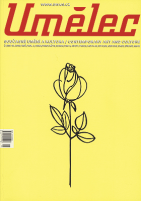| Revista Umělec 2000/4 >> The Great Graffiti Sell-Off | Lista de todas las ediciones | ||||||||||||
|
|||||||||||||
The Great Graffiti Sell-OffRevista Umělec 2000/401.04.2000 Františka a Tim Gilman-Ševčík | focus | en cs |
|||||||||||||
|
Arriving in New York used to feel like falling through a trap door into a dirty little secret. Ubiquitous filth and ecstatic energy, New York outlived the rest of America in extremes of high and low cramped magically into a tight little island bursting at the seams. It was more permissive than the puritanical hinterlands—here there was danger, balanced out by excitement, mess, offset by splendor, and the city was resolutely individual. It was so clearly differentiated from the rest of America, the people, the culture, the businesses. You had to take sides. Love it. Hate it.
Whether graffiti as we know it now was born in New York is debatable, but it was an acknowledged symbol of the city out of control—a human virus bursting out of the hothouse. It peaked in the early 1980s and washed into galleries, from rash to riches. Rebellion was bought up by collectors as culture, the blight of the poor and angry, elevated and celebrated. And names brought the street into the museums—Keith Haring, Kenny Scharf, Basquiat, the ones that got to be called artists, not graffiti artists—known by real names and not just their pseudonym tags. This is no longer that New York. Our new New York has opened its arms to tourists; it’s cleaner and smoother, has more of the same chain stores and mall mentality found in every other city and suburbia across the country. You can see the dregs of graffiti holding onto little scattered pockets on the fringes. But the wave was beaten down; the giant rolling canvases are gone. The subways are clean because for ten years now graffitied subway cars haven’t been allowed to go out. New York Mayor Giuliani spends $25 million fighting graffiti every year. And now New York has just seen the first major graffiti auction. That’s odd. An auction, now? The heyday of graffiti galleries is gone and museums put together graffiti shows that are much more scrubbed and savvy. The streets of the city are clean (well, cleaner, anyway), and it all makes this big sell-off like a fin de siecle, not the celebration of a vibrant counterculture. Graffiti is dead, let’s sell graffiti. You can’t buy and sell graffiti. Graffiti is in the spirit of break-in and bomb a wall, an overpass, a train car. Get away and hope it lasts a little while before defilement by the angry owners or your peers, other writers happy to cover or wreck your work. So the sellable kind is necessarily unillegal—it’s done on canvas or paper or whatever in someone’s studio. There’s nothing wrong with making and buying the sellable, portable, product kind of graffiti, though it’s just a representation of the real thing—it’s a sign that looks back nostalgically to illicit and dangerous moves made at night by bad boys on the edge. There’s no rush to get it up and get away. So without the danger and pressure it must change, it must do more because it loses the knife-edge, defiance in the face of the man. The stuff on paper and canvas and sheet metal and so on is graffiti-style. Graffiti graphics. Even if the same graffiti writer is putting the same paint up every night on walls. When he comes home and paints a picture he’s reminding us of a wild life that’s thrilling and scary and you can buy that reminder, but you both understand the difference. Unsurprisingly, the auction was a small failure; it didn’t bring in many big sales and won’t be the dawn of a new graffiti renaissance—it was just another auction dumping as much product as fast as possible. It did bring together such a wide swath of work from the very roots of the movement that individuality and personal style shone where it existed. The over-produced, slick graphicity of Zephyr has a respectable and refined commercial appeal. Crash’s Lichtenstein-esque, pop-comic images bridge time and genre—they’re sharp and lively. Tracy 168, a true pioneer, had one of the nicest pieces on the auction block—a working pinball machine painted inside and out and infested with the tags of other writers. It’s almost too easy to tout the tremendous virtues of the innocuous, powerful relics left by Keith Haring, early chalking drawings of his Everyman on blackened subway posters, and Jean-Michel Basquiat’s two perfect pencil drawings. One newcomer, with no 1970s street credibility but great postmodern style is Kaws, who steals advertising posters and doctors them up with his signature cartoon disfigurations before returning them to their place on the streets. But the best of the show were the nostalgic photos of the “burners,” full-length subway cars murals, eight feet high and forty feet long shot by Henry Chalfant, Jack Stewart, and Martha Cooper. As rolling ads for graffiti’s highest high, they are the horizontal tombstones of a vanished era. Graffiti Art Auction, Guernsey’s, June 14-15, 2000
01.04.2000
Artículos recomendados
|
|||||||||||||









Comentarios
Actualmente no hay comentariosAgregar nuevo comentario